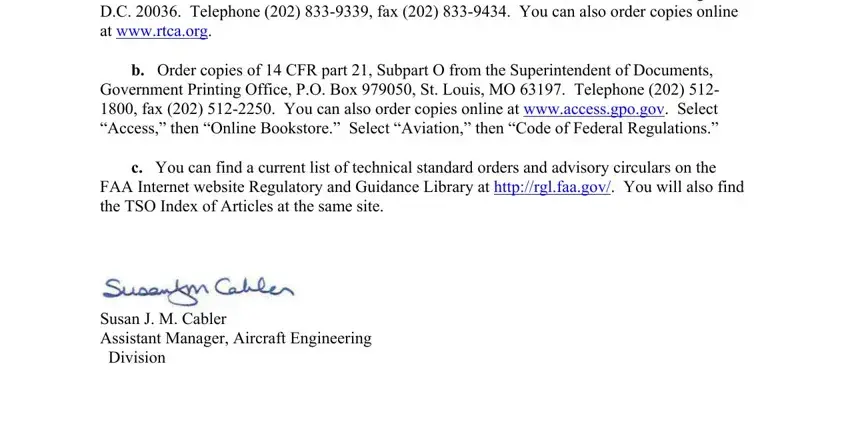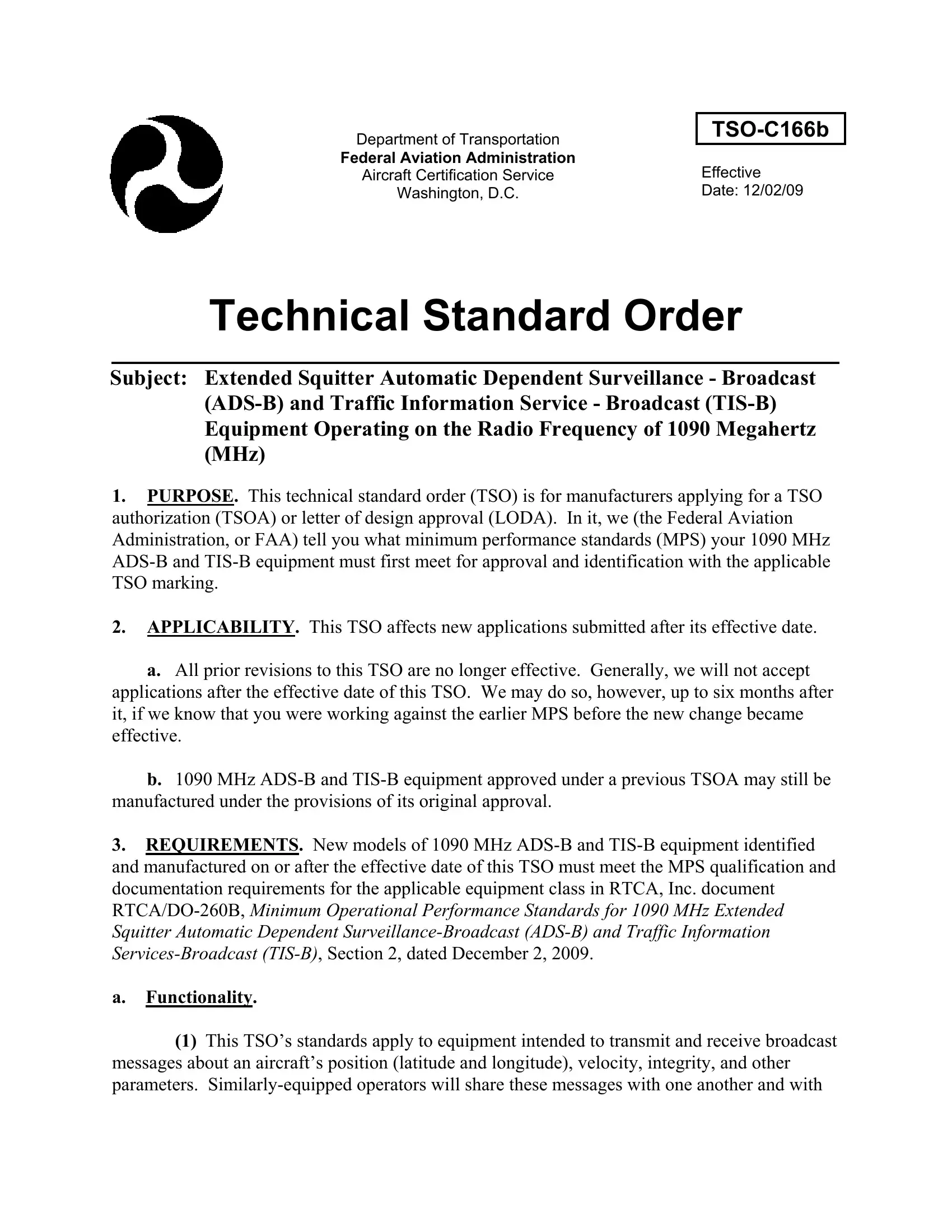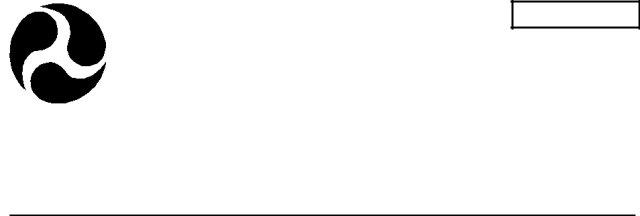Department of Transportation
FEDERAL AVIATION ADMINISTRATION
Aircraft Certification Service
Washington, D.C.
TSO-C166B
Effective Date: 12/02/09
TECHNICAL STANDARD ORDER
Subject: Extended Squitter Automatic Dependent Surveillance - Broadcast (ADS-B) and Traffic Information Service - Broadcast (TIS-B) Equipment Operating on the Radio Frequency of 1090 Megahertz (MHz)
1.PURPOSE. This technical standard order (TSO) is for manufacturers applying for a TSO authorization (TSOA) or letter of design approval (LODA). In it, we (the Federal Aviation Administration, or FAA) tell you what minimum performance standards (MPS) your 1090 MHz ADS-B and TIS-B equipment must first meet for approval and identification with the applicable TSO marking.
2.APPLICABILITY. This TSO affects new applications submitted after its effective date.
a.All prior revisions to this TSO are no longer effective. Generally, we will not accept applications after the effective date of this TSO. We may do so, however, up to six months after it, if we know that you were working against the earlier MPS before the new change became effective.
b.1090 MHz ADS-B and TIS-B equipment approved under a previous TSOA may still be manufactured under the provisions of its original approval.
3.REQUIREMENTS. New models of 1090 MHz ADS-B and TIS-B equipment identified and manufactured on or after the effective date of this TSO must meet the MPS qualification and documentation requirements for the applicable equipment class in RTCA, Inc. document RTCA/DO-260B, Minimum Operational Performance Standards for 1090 MHz Extended Squitter Automatic Dependent Surveillance-Broadcast (ADS-B) and Traffic Information Services-Broadcast (TIS-B), Section 2, dated December 2, 2009.
a.Functionality.
(1)This TSO’s standards apply to equipment intended to transmit and receive broadcast messages about an aircraft’s position (latitude and longitude), velocity, integrity, and other parameters. Similarly-equipped operators will share these messages with one another and with
ground-based facilities such as air traffic services. These message parameters form the basis for various ADS-B, ADS-R, and TIS-B reports.
(2)This TSO supports two major classes of 1090 MHz ADS-B equipment. Class A equipment consists of transmit and receive subsystems. Class B equipment contains a transmit subsystem only.
(a)Class A equipment includes Classes A1, A1S, A2 and A3 as defined in RTCA/DO-260B. We require 1090 MHz airborne Class A equipment to receive both ADS-B, ADS-R, and TIS-B messages, deliver ADS-B, ADS-R, and TIS-B reports, and transmit ADS-B messages. Class A equipment can also be defined as transmit only or receive only. Follow guidance in RTCA DO-260B paragraph 2.1.12.1 for transmit only or paragraph 2.1.12.2 for receive only equipment.
(b)Class B equipment includes Classes B1, and B1S as defined in
RTCA/DO-260B. Class B equipment is only required to transmit ADS-B messages.
(3)Use of ADS-B Reports in Airborne Applications. This TSO addresses only broadcasting messages from transmit subsystems and assembling reports in receiver subsystems. We don’t address applications that use the information in reports.
(4)Added Message Elements: Do not add ADS-B message elements outside of the message requirements outlined in Section 2 of DO-260B or populate message fields reserved for future use.
b.Failure Condition Classifications. For 1090 MHz ADS-B and TIS-B receiver subsystems, we consider an un-annunciated failure that provides onboard applications with incorrect reports a major failure condition. For 1090 MHz ADS-B transmitter subsystems, we consider an un-annunciated failure that broadcasts incorrect ADS-B messages a major failure condition. A failure resulting in loss of function defined in paragraph 3a of this TSO is considered a minor failure condition. Develop the system to, at least, the design assurance level equal to these two failure condition classifications.
NOTE: The major failure condition for transmission of incorrect ADS-B messages is based on use of the data by other aircraft or Air Traffic Control for separation services.
c.Functional Qualification. Demonstrate the required functional performance under the test conditions in RTCA/DO-260B, Section 2.4.
d.Environmental Qualification. Demonstrate the required performance under the test conditions specified in RTCA DO-260B Paragraph 2.3 using standard environmental conditions and test procedures appropriate for airborne equipment.
NOTE: Although no specific version of RTCA DO-160 environmental conditions and test procedures are specified, use of RTCA/DO-160D (with
Page 2
Changes 1 and 2 only, incorporated) or earlier versions will require substantiation via the deviation process as discussed in paragraph 3g of this TSO.
e.Software Qualification. If the article includes software, develop the software according to RTCA/DO-178B, Software Considerations in Airborne Systems and Equipment Certification, dated December 1, 1992. The software design assurance level should be consistent with the failure condition classifications defined in paragraph 3b of this TSO. Develop all software included in the article definition according to RTCA/DO-178B.
f.Electronic Hardware Qualification. If the article includes a complex custom micro- coded component to accomplish the function, develop the component according to RTCA/DO- 254, Design Assurance Guidance for Airborne Electronic Hardware. All complex custom micro-coded components included in the article definition must be developed according to RTCA/DO-254.
g.Deviations. We have provisions for using alternate or equivalent means of compliance to the criteria in the MPS of this TSO. If you invoke these provisions, you must show that your equipment maintains an equivalent level of safety. Apply for a deviation under 14 CFR 21.609.
4.MARKING.
a.Mark at least one major component permanently and legibly with all the information in
14CFR 21.607(d). The marking must include the serial number.
b.Also, mark the following permanently and legibly, with at least the manufacturer’s name, subassembly part number, and the TSO number:
(1)Each component that is easily removable (without hand tools), and
(2)Each subassembly of the article that you determined may be interchangeable.
c.If the article includes a deviation per paragraph 3g of this TSO, the marking must include a means to indicate a deviation was granted.
d.If the component includes a digital computer, then the part number must include hardware and software identification. Or, you can use a separate part number for hardware and software. Either way, you must include a means to show the modification status.
NOTE: Similar software versions, developed and tested to different software levels, must be differentiated by part number.
Page 3
e. Transmitting and receiving components must be permanently and legibly marked. The following table explains how to mark components. Find the equipment class in RTCA/DO- 260B, Section 2.1.11 and the receiving equipment type in RTCA/DO-260B, Section 2.2.6.
If component can: |
Mark it with: |
Sample marking pattern: |
|
|
|
Transmit and |
Equipment class it supports, and |
Class A1/Type 1 |
receive |
Receiving equipment type |
|
Transmit, but not |
Equipment class it supports |
Class B1 or |
receive |
|
Class A3 - Transmit Only |
Receive, but not |
Equipment class it supports, and |
Class A2/Type 2 - Receive |
transmit |
Receiving equipment type |
Only |
5.APPLICATION DATA REQUIREMENTS. You must give the FAA aircraft certification office (ACO) manager responsible for your facility a statement of conformance, as specified in
14CFR 21.605(a)(1) and one copy each of the following technical data to support your design and production approval. Under 14 CFR 21.617(a)(2), LODA applicants submit the same data (excluding paragraph 5h) through their civil aviation authority.
a.Operating instructions and equipment limitations in an installation manual (IM), sufficient to describe the equipment’s operational capability. Describe in detail any deviations. If needed, identify equipment by part number, version, revision, and criticality level of software/hardware, classification for use, and environmental categories.
b.Installation procedures and limitations in an IM, sufficient to ensure that the 1090 MHz ADS-B equipment, when installed according to the installation procedures, still meets this TSO’s requirements. For non-transponder-based 1090 MHz ADS-B transmitting equipment, manufacturers must include a limitation stating that the equipment cannot be co-installed in aircraft with a Mode-S transponder (see RTCA/DO-260B Section 3.0). Limitations must identify any unique aspects of the installation. The limitations must include a note with the following statement:
This article meets the minimum performance and quality control standards required by a technical standard order (TSO). If you are installing this article on or in a specific type or class of aircraft, you must obtain separate approval for installation.
c.Schematic drawings of the installation procedures.
d.Wiring diagrams of the installation procedures.
e.List of components, by part number, that makes up the 1090 MHz ADS-B and TIS-B article. Include vendor part number cross-references, when applicable.
Page 4
f.A component maintenance manual (CMM) or IM, as appropriate, covering periodic maintenance, calibration, and repair, for the continued airworthiness of the 1090 MHz ADS-B and TIS-B equipment. Include recommended inspection intervals and service life, as appropriate.
g.Material and process specifications list.
h.The quality control system (QCS) description required by 14 CFR 21.143 and 21.605(a)(3), including functional test specifications. The QCS should ensure that you will detect any change to the approved design that could adversely affect compliance with the TSO MPS, and reject the article accordingly. (Not required for LODA applicants.)
i.Manufacturer’s TSO qualification report showing results of testing accomplished according to paragraph 3c of this TSO.
j.Nameplate drawing with the information required by paragraph 4 of this TSO.
k.List of all drawings and processes (including revision level) that define the article’s
design.
l.A summary of the test conditions used for environmental qualifications for each component of the article. For example, a form as described in RTCA/DO-160F, Environmental Conditions and Test Procedures for Airborne Equipment, Appendix A.
m.If the article includes software: a plan for software aspects of certification (PSAC), software configuration index, and software accomplishment summary. We recommend that you submit the PSAC early in the software development process. Early submittal allows us to quickly resolve issues, such as partitioning and determining software levels.
n.If the article includes a complex custom micro-coded component: a plan for hardware aspects of certification (PHAC), hardware verification plan, top-level drawing, and hardware accomplishment summary. We recommend that you submit the PHAC early in the hardware development process. Early submittal allows us to quickly resolve issues.
o.Identify functionality, features or performance contained in the article that is not evaluated under paragraph 3 of this TSO (i.e. non-TSO functions). These functions are not approved under 14 CFR 21 Subpart O authorization, but can be approved in conjunction with the TSO authorization under the authority of 14 CFR 21.305(d). You must include the following information with your TSO application:
(1)Description of the non-TSO function(s), such as performance specifications and software, hardware, and environmental qualification levels. Add a statement confirming that the non-TSO functions don’t interfere with the article’s compliance with the requirements of paragraph 3.
Page 5
(2)Installation and operating instructions/limitations for the non-TSO function(s). The IM must contain the following statement: “The non-TSO functions defined in this section are not part of the TSO approval. The non-TSO function data included in this section is approved under 14 CFR 21.305(d).”
(3)Instructions for continued performance applicable to the non-TSO function(s) defined in paragraph 5o(1).
(4)Interface requirements and applicable installation test procedures to ensure compliance with the performance data defined in paragraph 5o(1).
(5)Results of test/analysis, as appropriate, to verify that performance of the hosting TSO article is not affected by the non-TSO function(s).
(6)Results of test/analysis, as appropriate, to verify intended function of the declared non-TSO function(s) as described in paragraph 5o(1).
6.MANUFACTURER DATA REQUIREMENTS. Besides the data given directly to us, have the following technical data available for review by the responsible ACO or civil aviation authority:
a.Functional qualification specifications for qualifying each production article to ensure compliance with this TSO.
b.Equipment calibration procedures.
c.Corrective maintenance procedures (within 12 months after TSOA or LODA).
d.Schematic drawings.
e.Wiring diagrams.
f.Material and process specifications.
g.The results of the environmental qualification tests conducted according to paragraph 3d of this TSO.
h.If the article includes software, the appropriate documentation defined in
RTCA/DO-178B including all data supporting the applicable objectives in RTCA/DO-178B Annex A, Process Objectives and Outputs by Software Level.
i.If the article includes a complex micro-coded component, the appropriate hardware life cycle data in combination with design assurance level, as defined in RTCA/DO-254, Appendix A, Table A-l.
Page 6
j. If the article contains non-TSO function(s), you must also make available items 6a through 6i as they pertain to the non-TSO function(s).
7.FURNISHED DATA REQUIREMENTS.
a.If furnishing one or more articles manufactured under this TSO to one entity (such as an operator or repair station), provide one copy of the data in paragraphs 5a through 5f and 5l of this TSO. Add any other data needed for the proper installation, certification, use, or for continued compliance with the TSO, of the 1090 MHz ADS-B and TIS-B equipment.
b.If the article contains non-TSO function(s), include one copy of the data in paragraphs 5o(1) through 5o(4).
8.HOW TO GET REFERENCED DOCUMENTS.
a.Order RTCA documents from RTCA Inc., 1828 L Street NW, Suite 805, Washington, D.C. 20036. Telephone (202) 833-9339, fax (202) 833-9434. You can also order copies online at www.rtca.org.
b.Order copies of 14 CFR part 21, Subpart O from the Superintendent of Documents, Government Printing Office, P.O. Box 979050, St. Louis, MO 63197. Telephone (202) 512- 1800, fax (202) 512-2250. You can also order copies online at www.access.gpo.gov. Select “Access,” then “Online Bookstore.” Select “Aviation,” then “Code of Federal Regulations.”
c.You can find a current list of technical standard orders and advisory circulars on the FAA Internet website Regulatory and Guidance Library at http://rgl.faa.gov/. You will also find the TSO Index of Articles at the same site.
Susan J. M. Cabler
Assistant Manager, Aircraft Engineering
Division
Page 7





